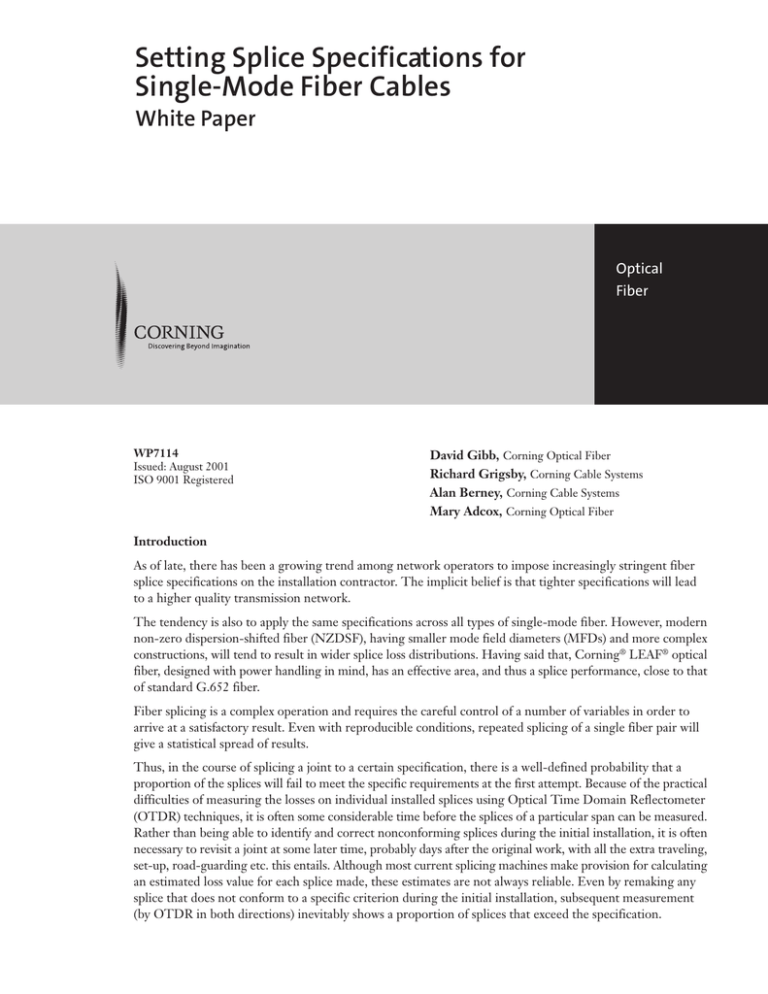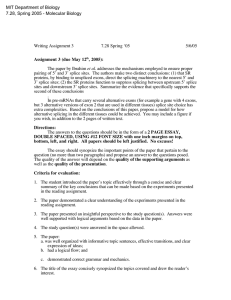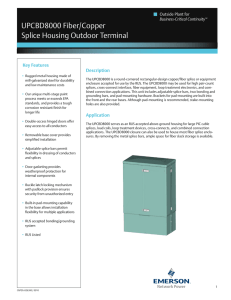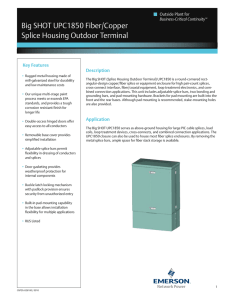Setting Splice Specifications for Single-Mode fiber Cables
advertisement

Setting Splice Specifications for Single-Mode Fiber Cables White Paper Optical Fiber WP7114 Issued: August 2001 ISO 9001 Registered David Gibb, Corning Optical Fiber Richard Grigsby, Corning Cable Systems Alan Berney, Corning Cable Systems Mary Adcox, Corning Optical Fiber Introduction As of late, there has been a growing trend among network operators to impose increasingly stringent fiber splice specifications on the installation contractor. The implicit belief is that tighter specifications will lead to a higher quality transmission network. The tendency is also to apply the same specifications across all types of single-mode fiber. However, modern non-zero dispersion-shifted fiber (NZDSF), having smaller mode field diameters (MFDs) and more complex constructions, will tend to result in wider splice loss distributions. Having said that, Corning® LEAF® optical fiber, designed with power handling in mind, has an effective area, and thus a splice performance, close to that of standard G.652 fiber. Fiber splicing is a complex operation and requires the careful control of a number of variables in order to arrive at a satisfactory result. Even with reproducible conditions, repeated splicing of a single fiber pair will give a statistical spread of results. Thus, in the course of splicing a joint to a certain specification, there is a well-defined probability that a proportion of the splices will fail to meet the specific requirements at the first attempt. Because of the practical difficulties of measuring the losses on individual installed splices using Optical Time Domain Reflectometer (OTDR) techniques, it is often some considerable time before the splices of a particular span can be measured. Rather than being able to identify and correct nonconforming splices during the initial installation, it is often necessary to revisit a joint at some later time, probably days after the original work, with all the extra traveling, set-up, road-guarding etc. this entails. Although most current splicing machines make provision for calculating an estimated loss value for each splice made, these estimates are not always reliable. Even by remaking any splice that does not conform to a specific criterion during the initial installation, subsequent measurement (by OTDR in both directions) inevitably shows a proportion of splices that exceed the specification. Any splice that must be revisited after the initial installation is termed rework. Such rework on a contract has an associated expense, and this will be reflected in the cost and time taken to complete the installation. The bulk of the time and cost of rework lies not in the time taken to remake and retest the splices themselves, but in the time it takes to reopen and close a joint to carry out the work. If the number of joints that require rework can be minimized without prejudicing the system performance, overall costs will be significantly reduced. There are three ways to reduce the amount of rework necessary in such a situation: 1. By improving splicing equipment and techniques to give a higher proportion of low-loss splices at the first attempt. Such developments are continuing. 2. By improving estimation techniques to improve correlation between bi-directionally measured OTDR values and splice machine estimated values, so that on-the-spot remakes can guarantee that a splice will conform to the required specification. Such techniques are still some way off. 3. By adopting specifications that guarantee the system performance envelope required by the network operator but do not call for a level of splice quality that is neither necessary nor practical. Previous papers have addressed Item (3) from a purely mathematical standpoint (1). In this paper we combine this approach with data from an actual field installation. Terminology For the purposes of this paper, we have defined the following terms: • Cable section – a single cable length with a joint at each end; • Span – the network between optical amplifiers, comprising several cable sections and their associated joints; • Link – the optical network between electrical-to-optical and optical- to-electrical conversions (i.e., terminal to terminal), usually comprising several spans and their associated amplifiers; • Joint – a splice enclosure. Existing Installation Splice Specifications It is important at this point to understand precisely what a network operator really requires from his system before judging whether a particular specification is sensible and practical. Table 1 lists some of the specifications being imposed on new NZDSF builds in Europe today, which are similar in North America and worldwide. Typical European Installation Specifications Table 1 2-way OTDR Mean (dB) SPECIFIER Each Splice Maximum Splice Average (over Span) One Direction Max (dB) Network 1 0.08 *** 0.1 Network 2 0.08 *** *** Network 3 0.10 0.08 *** Network 4 0.10 0.08 +/-0.15 Network 5 0.15 0.1 *** The table shows a wide variation of requirements, which each network builder has deemed necessary, prompting the following questions. a) Does the network builder really need a system in which each splice meets a maximum value? Can this be justified and, if so, is the value set at sensible and practical limits? b) Does the network builder simply need a system in which the overall average splice loss over a span meets a particular specification? c) What is the purpose of specifying a maximum one-way loss? 2 What Parameters are Really Required in an Installation Specification? In legacy systems, span lengths were traditionally limited by attenuation, and splice specifications were of paramount importance in network design. For this reason, many of the original specifications remain in place today. Ultimately, the transmission performance depends upon the overall optical loss between transmitter and receiver; how that loss is distributed across the link, or any individual span, is immaterial. For this reason there is no added value in placing strict requirements on the optical loss of any particular splice. It should also be noted that individual OTDR measurements are subject to limitations of accuracy, typically up to ±0.02dB. Thus the two-way average of any particular splice measurement could potentially be in error by as much as 0.04dB (worst-case). This in itself makes the imposition of maximum individual loss specifications somewhat questionable. Finally, it is well documented(2) that without detailed knowledge of the fiber MFDs, single direction OTDR measurements of splice loss are of little value. Indeed such measurements can be misleading, by implying that a particular loss (as a result of an MFD mismatch) is artificially large, or even negative. What is the impact of insisting on a single splice specification? Having suggested that the only real value, in terms of transmission performance, is in the specification of overall span splice loss, it is not unreasonable to table the question: what are the implications of demanding that individual splices meet a particular criterion? Using a theoretical distribution of LEAF fiber splices, we performed a statistical (Monte Carlo technique) analysis of the yields achievable with both a single splice requirement and an average span requirement. The full details of this analysis are shown in Appendix A. The analysis demonstrates the following: 1. With a single splice specification limit of 0.08dB, the best yield achievable is 91% (i.e., 9% of all splices will require revisit and rework). 2. If we only impose a 0.08dB specification on the average span splice loss, we can achieve 100% conformance (i.e., no rework) provided we have at least six joints in the span (a condition that would apply to most long-haul installations). The implications are clear - a single “high” splice in a span may have little impact on the total span loss, but current specifications would demand that the installer revisit the site of the splice in question. What impact does such rework have? 1. Time delays - in today’s market, the sooner a network operator can light their network, the sooner it can begin to pay for itself 2. Costs - most contractors bid based upon the specification - they know from experience that a tighter spec requires more rework, so they will price their tender accordingly 3. Introduction of faults - clearly in a splice enclosure containing many fibers, reworking one fiber presents a risk of disturbing neighboring fibers Appendix B describes in more detail the background and sequence of events associated with span installation and rework. The model on which the theoretical analysis is based uses data that takes into account the manufacturing distribution of fiber mode field diameter and core-clad concentricity. Because it is a theoretical model, it does not take into account the realities of splicing in an outside environment. The following is a more in-depth analysis of data from a real field installation. 3 Cable Installation Analysis The following example refers to an actual 96-fiber loose-tube LEAF fiber (G.655) cable installation carried out in the United Kingdom in late 2000. Seventeen cable sections having an average length of ~6km were jointed using active profile alignment splicing machines (16 joints). Due to the complexity of the route access, machine estimates were the only guide to quality during splicing. Any splice perceived from visual inspection or machine estimate to be potentially unsatisfactory was remade on the spot. All the joints were then closed. No OTDR testing was possible until after all 16 joints had been completed. Figure 1 shows the result of the two-directional OTDR analysis of the 16 joints, carried out before any rework. It shows a lower proportion (84%) of splices meeting a 0.08 dB specified maximum than the 91 % predicted by the theoretical model; this could be attributable to local conditions or working practices. Individual Splice Loss Before Rework Figure 1 96-Fiber Installation Containing LEAF Fiber BEFORE Rework (16 joints-1536 splices) -Individual splice loss 300 100 80 70 Frequency 200 150 Cumulative frequency 60 Frequency 50 40 100 30 20 50 Cumulative Frequency (%) 90 250 10 0 0 0 01 0. 02 0. 03 0. 04 0. 05 0. 06 0. 07 0. 08 0. 09 0.1 .11 .12 .13 .14 .15 .16 .17 .18 .19 0.2 ore 0 0 0 0 0 0 0 0 0 M 0. Individual Splice Loss (dB) We now analyze this data from a number of specification scenarios. The assumption is made that, based upon existing specifications, satisfactory transmission is achieved provided the total splice loss over any span does not exceed N x 0.08 dB (N being the number of joints in the span). For the purposes of this example it has been assumed that any splice after rework has a loss of 0.05 dB, this being the typical mean loss for LEAF fiber splicing(2). SCENARIO 1 Requirement: All Individual Splices ≤ 0.08 dB In this case, our data shows that all 16 joints would need to be opened, and a total of 264 individual splices remade. Clearly this would be a very time-consuming and costly process. Figures 2a and 2b show the distribution of span average splice loss for all fibers in the cable, before and after rework to this specification. Clearly, reworking every nonconforming splice gives us a span average of 0.06 dB or better. This is no doubt a satisfactory situation for the network operator but at what cost was it achieved and is the extra margin (as seen in the last column of Table 2) really needed? 4 Figure 2a Figure 2b 96-Fiber Installation Containing LEAF Fiber BEFORE Rework (16 joints) - Every Splice Loss per Fiber Span 30 80 25 70 60 Frequency Frequency 96-Fiber Installation Containing LEAF Fiber BEFORE Rework (16 joints) - Mean Splice Loss per Fiber Span 20 15 10 50 40 30 20 5 10 0 0.2 0.18 0.16 0.14 0.12 0.1 0.08 0.06 0.04 0.02 0.2 0.18 0.16 0.14 0.12 0.1 0.08 0.06 0.04 0.02 0 0 0 Mean Splice Loss per Fiber Span (16 Joints) Mean Splice Loss per Fiber Span (16 Joints) SCENARIO 2 Requirement: Span Splice average ≤ 0.08dB, Max splice ≤ S Here we maintain the requirement for a maximum individual splice loss at a pre-determined value S, but review how far S may be relaxed while maintaining the span average ≤ 0.08dB. Table 2 shows the number of splices it would be necessary to rework, and the number of joints it would be necessary to reopen, to achieve various values for S. It also shows the effect of altering S on the worst case (over all fibers) loss per splice averaged over the whole span. Table 2 S ( dB) 1536 splices Splices requiring rework 16 joints Joints requiring revisit Resultant Maximum Span Average Splice Loss 0.08 264 16 0.058 0.09 196 16 0.060 0.10 150 16 0.063 0.11 113 14 0.065 0.12 93 14 0.068 0.13 79 13 0.076 0.14 61 13 0.076 0.15 50 11 0.076 0.20 22 8 0.076 Using the blanket reworking approach, i.e., reworking every splice in every fiber greater than a certain value, it is found in this example to be necessary to rework any splices that are >0.20 dB to bring the average splice loss of every fiber span below 0.08 dB. (This is shown in Figure 2c). Table 2 shows that to achieve this result, it would be necessary to revisit 8 of the 16 joints and rework 22 splices. This represents a significant saving in cost and time compared to Scenario 1 - greater than 50% in this case. The Effect on Span of Reworking Every Splice >0.20 dB Figure 2c Frequency 96-Fiber Installation Containing LEAF Fiber BEFORE Rework (16 joints) - Every Splice >0.20 dB Reworked 45 40 35 30 25 20 15 10 5 0 0.2 0.18 0.16 0.14 0.12 0.1 0.08 0.06 0.04 0.02 0 Mean Splice Loss per Fiber Span (16 joints) 5 SCENARIO 3 Requirement: Span Splice average ≤ 0.08 dB, Max individual splice loss not specified Here an overall span splice average of 0.08 dB is maintained, using the minimum amount of rework. In this scenario, our analysis shows that for this 16-joint span it was only necessary to rework four splices (those highlighted in Fig 2a) in three joints, as depicted in Table 3. Such an approach is obviously the most economical in time and cost. Table 3 S (dB) 1536 splices Splices requiring rework Not specified 16 joints Joints requiring revisit 4 3 Some network operators may contend that allowing relatively high loss splices to remain in a system could affect its reliability and stability. There is no evidence to suggest that a high loss splice implies a mechanical weakness (today’s active alignment splicers are configured to strength-test all splices, thereby assuring longterm mechanical reliability). It is interesting to note that some splice machines include the facility for making splices with purposely offset alignment, which are included as attenuators in some systems, without any evident ill-effects. Note: A splice having a loss of 0.5 dB can result from a core offset of only ~1.5 µm. The Effect of the Number of Joints in the Span We have shown that the more joints there are in a particular span, the higher the probability that the rework level can be limited, either by improving a few high loss splices or by blanket reworking to some appropriate level. However some spans could incorporate fewer than the six joints which the theory (Appendix A) predicts to be the minimum requirement. Our chosen field example considered a span of 93 km, made up of 17 cable sections and 16 joints, believed to be conservative for today’s long-haul installations. For a greater number of sections, statistically the prerework averages will be better, and the rework required (to maintain only the average span budget) should be less again. Conversely, in the rare event of fewer sections in the span, the installation may require proportionately more rework. The Effect of the Cable Fiber-Count The higher the fiber-count of the cable, the higher the probability that any joint will require reopening to carry out rework to meet any given specification. The above field installation example was analyzed to explore the effect of reducing the number of fibers in the cable from 96, on both the number of fibers requiring rework and, more importantly, on the number of joints to be reopened. Table 4 shows these results. Table 4 Fiber Count Spec. Max (dB) 6 96 48 24 No. of Splices requiring rework 96 48 24 No. of Joints requiring rework 0.08 264 130 70 16 16 14 0.09 196 98 52 16 16 14 0.10 150 78 44 16 14 13 0.11 113 57 35 14 12 11 0.12 93 43 25 14 11 7 0.13 79 36 21 13 10 7 0.14 61 29 17 13 9 6 0.15 50 23 13 11 9 6 0.20 22 12 6 8 8 4 Economic Model Cost modeling of cable installations can be complex, since a multitude of factors must be taken into account. For example, (as reported) in our field study there was a need to protect the joint team working at certain sites by the deployment of traffic signals. In these cases, it is common for seven days notice to be required before the joint is accessible and work is typically restricted to daylight hours. Three joints in this installation were affected in this way; such factors can increase the cost of rework considerably. However to simplify the example, it has been assumed that all joints are accessible at all times, with no signals required. The assumptions are listed in Table 5. The results of our simple economic analysis are shown in Table 6, and plotted in Figures 3 and 4. Cost / Time Model Assumptions Table 5 Time to Rework to Various Specification Requirements Table 6 Fixed Time for Reopening a Joint Time (minutes) Travelling to joint location (Average) 30 Road guarding 7 SPECIFICATION Indiv. Splice Max (dB) Time to rework (hours) Opening joint-box 10 0.08 77.87 Pumping out box/gas testing etc. 10 0.09 64.27 Removing joint/preparing workspace 10 0.10 55.07 Opening joint 5 0.11 44.53 Closing joint 5 0.12 40.53 Putting joint away/stowing cable etc. 10 0.13 36.17 Remove road guarding etc. 7 0.14 32.57 94 0.15 27.23 0.20 16.93 Total Variable Time for Reopening a Joint Time to identify each out-of-spec splice 5 Span Splice Average (dB) Time to re-splice and protect 2 0.08 Time to retest one-way 3 Time to put away reworked splices 5.50 2 Total per splice 12 Number of splices requiring remedial work: N Total variable time per joint Nx12 Total Time for Reopening Joint 94+Nx12 Figure 3 Time to rework 17-span 96-fiber cable to various specifications 90 Time to rework (hrs) 80 70 60 50 40 30 20 10 Time to rework where only the average span splice loss is specified 0 0.07 0.09 0.11 0.13 0.15 0.17 0.19 0.21 Splice loss specification (dB) 7 Figure 4 Time to rework 17-section cable span to ‘blanket’ specifications for various fiber-count cables 80 Time to rework (hrs) 70 60 96f Cable 50 40 48f Cable 30 24f Cable 20 10 0 0.05 0.10 0.15 0.20 0.25 Max. Individual Splice Loss Spec (dB) Conclusions Existing specifications for field installation of long-haul cables vary considerably in their requirements, and often bear little relevance to necessity or practicality. In terms of transmission capability, we have found no added value in specifying how optical loss is distributed in a cable span. However, we have demonstrated that strict adherence to a specification which imposes requirements on an individual splice in a span may be detrimental in terms of increased cost and time during installation. Ideally, network builders would move away from such specifications, and focus rather on the overall link. That said, our data suggests that it is still possible to impose some requirement on individual splice loss and still achieve considerable savings without compromising transmission budgets. For example, altering the individual splice specification in our field study from 0.08 dB to 0.15 dB generates 60% savings in rework resources, while comfortably leaving all spans well within the budget requirement. Appendix A: Theoretical Splice Loss Modelling The splice yields presented in Table 7 were generated using an active alignment splice loss model that employs Monte Carlo techniques. The model incorporates the standard splice loss equations and the manufacturing distribution for the fiber, and creates a distribution of expected splice losses for LEAF fiber to LEAF fiber splicing. As well as demonstrating the yield benefits of moving from a single splice max to an average splice maximum, the table also shows that as the span specification is loosened, the number of sections required to achieve 100% conformance is less (as would be expected intuitively). Note that the analysis also assumes that best practices in field splicing are observed - failure to adhere to these can seriously impact the splice distribution. If good technique is followed, it should be possible, certainly with longer links, to confidently ‘blind-splice’, i.e. rely on the overall link being within required budget, without the need to perform OTDR checks during live splicing. 8 Span Yields vs. Numbers of Splices for Active Alignment Splicing Table 7 Splice Yields for Corning LEAF Optical Fiber 1 Splice 2 Splices 3 Splices 4 Splices 5 Splices 6 Splices 7 Splices Budget per splice 0.08 dB 0.08 dB 0.08 dB 0.08 dB 0.08 dB 0.08 dB 0.08 dB Span splice loss budget 0.08 dB 0.16 dB 0.24 dB 0.32 dB 0.40 dB 0.48 dB 0.56 dB 91% 95% 98% 99% 99% 100% 100% N/A N/A N/A N/A N/A 0.45 dB 0.50 dB N/A N/A N/A N/A N/A 99% 99% Budget per splice 0.10 dB 0.10 dB 0.10 dB 0.10 dB 0.10 dB 0.10 dB 0.10 dB Span splice loss budget 0.10 dB 0.20 dB 0.30 dB 0.40 dB 0.50 dB 0.60 dB 0.70 dB 97% 99% 100% 100% 100% 100% 100% N/A N/A 0.25 dB 0.33 dB 0.40 dB 0.45 dB 0.50 dB N/A N/A 99% 99% 99% 99% 99% Budget per splice 0.12 dB 0.12 dB 0.12 dB 0.12 dB 0.12 dB 0.12 dB 0.12 dB Span splice loss budget 0.12 dB 0.24 dB 0.36 dB 0.48 dB 0.60 dB 0.72 dB 0.84 dB 100% 100% 100% 100% 100% 100% 100% 0.11 dB 0.20 dB 0.25 dB 0.33 dB 0.40 dB 0.45 dB 0.50 dB 98% 99% 99% 99% 99% 99% 99% % meeting span budget Tightened span splice loss budget % meeting tightened span budget % meeting span budget Tightened span splice loss budget % meeting tightened span budget % meeting span budget Tightened span splice loss budget % meeting tightened span budget Appendix B - Span Installation and the Reality of Rework The advent of “long-haul” optical cables has meant the provision of new directly buried duct routes. There is considerable competition among carriers to provide a service between the same population centres. The preferred routes are the shortest distance between any two points along public thoroughfares. This practice affords easy access for maintenance and future expansion. “Communication corridors” have developed in some countries, and the competition for space is exacerbated by the presence of existing utilities. This inevitably leads to civil work problems in some sections of route containing existing telecommunication cables, buried plant, river and rail crossings, etc. and these sections require more construction time. Thus the civil works progress at different rates throughout the route and gaps in the route are still there when cable installation and splicing is underway. It is good practice to install cables in consecutive sections of route. Thus jointing and testing can be done in an orderly fashion and splice quality can be progressively monitored, frequently in real time. In recent telecommunication schemes, time constraints have dictated that jointing work starts as soon as possible after cable installation commences, and this is usually at an interval of one week. Consecutive cabling has not been possible throughout a span, because of civil work delays, thus jointing work has been sporadic and isolated and testing to monitor splice quality is not possible until the span is almost complete. Hence any rework required to improve the quality of some splices means that a number of joint locations must be revisited, entailing the setting up of a safe work site at each joint with numerous access problems. This is both costly and time consuming and both the contractor and customer would benefit by minimizing the amount of rework. In practice, the jointing work is frequently so fragmented that the span is completed prior to being tested with an OTDR in both directions to determine the amount of fiber splices that are outside the specification. 9 Cable is ordered in advance of the contract and provided in standard lengths to simplify future maintenance, minimize wastage and replacement cable requirements. This compromises the surveyor’s ability to locate access boxes in convenient locations and dictates to some extent the position of the joints. Most joint locations are situated in the roadway, thus requiring the placement of warning signs at appropriate advanced distances on both sides of the work site and the placement of traffic cones and barriers at the site. When the roadway is narrow or the position of the box impedes the safe passage of vehicles, automatic traffic signals may need to be provided. To deploy traffic signals in the United Kingdom requires written permission from the local authorities and seven days advance notice. Local laws or traffic sensitive areas may limit access times to some locations. Weather conditions and daylight hours also limit the scope of access. The joint is secured to a wall mounted bracket and has to be made with sufficient cable coiled and secured within the box to enable it to be remade if required in the future (see Figure 5). Further excess cable is required to enable the removal of the joint from the box and allow temporary placement in a van to enable any rework to be carried out. Joint boxes situated in the roadway are fitted with heavy, cast iron carriageway lids requiring two men to lift them off. Most joint boxes fill with water and this must be pumped out and disposed of to gain access. Checks must be made for the presence of explosive, poisonous or asphyxiating gases prior to entering a box. When the joint has been removed, placed in a secure position on a bench within the van and the joint cover removed, rework can be started. A tester is stationed at one end of the span with an OTDR and monitors the activities of the jointer. The jointer must locate and withdraw the correct fiber from the eight, twelve, or twenty four fibers present in the same cassette or tray, prepare the fiber and re-splice it. If the splice quality has been improved sufficiently the fiber can be coiled and replaced in the cassette; if not, it may be necessary to re-splice it again. There is a risk of disturbing or introducing faults in neighboring fibers during rework, therefore such work should be kept to a minimum. When all the rework required is complete the joint is closed, pressurized to check for leaks and returned to the joint box. The excess cable is coiled and secured in the joint box and the joint is fixed to the retaining bracket. The box lids are replaced and the work-site is dismantled systematically. All barriers, traffic cones and road signs are recovered and stowed within the van. The joint team is now ready for deployment at another location. When all identified rework within a span is complete, OTDR tests are redone and analyzed in both directions on all fibers to check the splice quality and to ensure that no other faults have been introduced during the remedial process. References 1. P.Lindskog, B.Sundstrom, J.Tyrcha and R.Sundberg, “Minimise Network Installation Costs by Setting Appropriate Maximum Splice Loss Values,” Proc.IWCS 1998, pp.522-526 2. M.E.White and S.A.Cooper, “Splice Loss in Non-Zero Dispersion-Shifted Fibers,” Proc.IWCS 1998, pp.891-896 10 11 Corning Incorporated www.corning.com/opticalfiber One Riverfront Plaza Corning, NY 14831 U.S.A. Phone: 800-525-2524 (U.S. and Canada) 607-786-8125 (International) Fax: 800-539-3632 (U.S. and Canada) 607-786-8344 (International) Email: info@corningfiber.com Europe Berkeley Square House Berkeley Square London W1X 5PE U.K. Phone: 00 800 2800 4800 (U.K.*, Ireland, France, Germany, The Netherlands, Spain and Sweden) *Callers from U.K. dial (00) before the phone number 00 800 781 516 (Italy) +44 7000 280 480 (All other countries) Fax: +44 7000 250 450 Email: europe@corningfiber.com Asia Pacific Greater China Australia Phone:1-800-148-690 Fax: 1-800-148-568 Beijing Phone: (86) 10-6505-5066 Fax: (86) 10-6505-5077 Indonesia Phone: 001-803-015-721-1261 Fax: 001-803-015-721-1262 Hong Kong Phone: (852) 2807-2723 Fax: (852) 2807-2152 Malaysia Phone: 1-800-80-3156 Fax: 1-800-80-3155 Philippines Phone: 1-800-1-116-0338 Fax: 1-800-1-116-0339 Singapore Phone: 800-1300-955 Fax: 800-1300-956 Shanghai Phone: (86) 21-6361-0826 ext. 107 Fax: (86) 21-6361-0827 Taiwan Phone: (886) 2-2716-0338 Fax: (886) 2-2716-0339 E-mail: luyc@corning.com Thailand Phone: 001-800-1-3-721-1263 Fax: 001-800-1-3-721-1264 Latin America Brazil Phone: 000817-762-4732 Fax: 000817-762-4996 Mexico Phone: 001-800-235-1719 Fax: 001-800-339-1472 Venezuela Phone: 800-1-4418 Fax: 800-1-4419 12 Corning is a registered trademark of Corning Incorporated, Corning, N.Y. ©2001, Corning Incorporated



